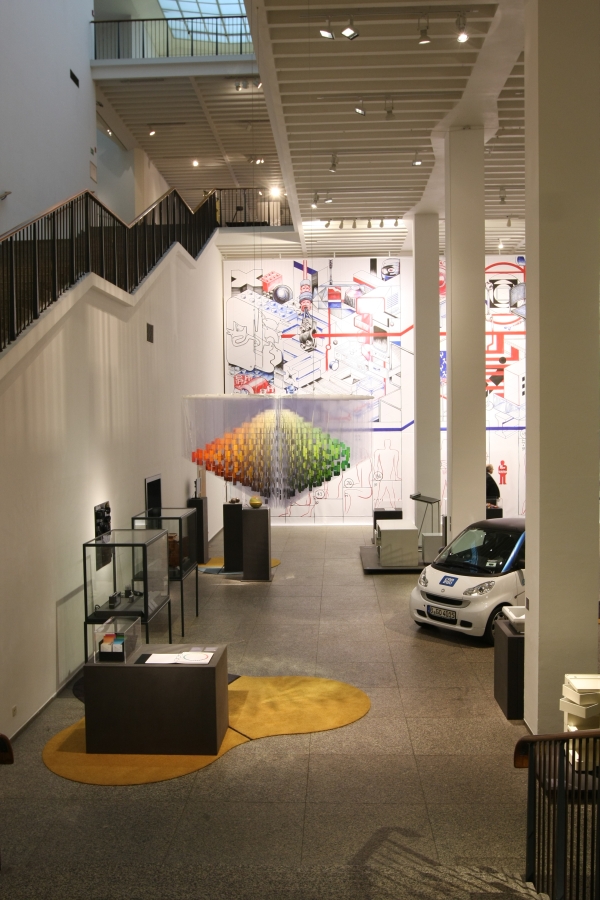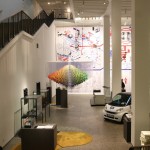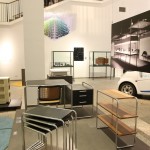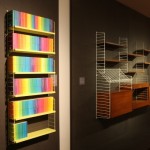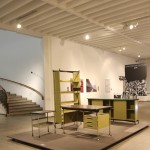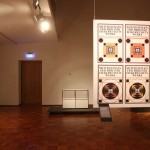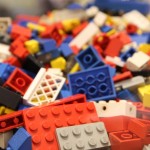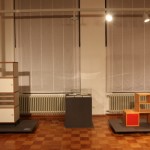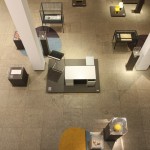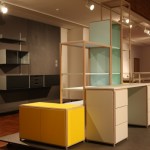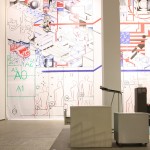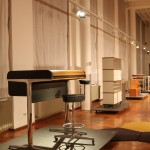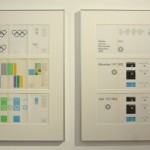SYSTEM DESIGN. Über 100 Jahre Chaos im Alltag at the Museum für Angewandte Kunst Köln
The history of civilisation is in many respects a history of man understanding natural systems, for example, the inner workings of the human body, the principles of evolution or the nature of the solar system.
Each understanding bringing us further forward and opening new possibilities.
Similarly the history of industry and economics is the history of man developing systems.
Back in 1895 William Painter, head of the Crown Cork & Seal company gave King Camp Gillette the advice that if he wanted to get rich he should, “invent something people use and throw away“. The result was the disposable safety razor blade. And a very, very rich King Camp Gillette.
What William Painter actually meant was, “if you want to get rich, devise a system”: for well designed systems were and are the basis of our modern industry and as such represent one of the best examples of the value design brings to traditional crafts and engineering.
For their major spring 2015 exhibition the Cologne Museum of Applied Art, MAKK, are presenting SYSTEM DESIGN. Über 100 Jahre Chaos im Alltag – SYSTEM DESIGN. A 100 Years of Daily Chaos – an exploration of the history of system design and the variety of systems that have arisen.
Before one can organise an exhibition about system design, one must obviously be able to define systems in a design context.
“A system”, according to curator Dr René Spitz, “is a man-made construction with which we bring order to chaos in that we connect things which for us belong together in such a way that it has a meaning for us”
An understanding of systems which of course places the connector, the joining element, at the centre of systems, or perhaps better put reduces systems down to a basic element, be that King Camp Gillette’s safety blade or, for example, the connecting ball Fritz Haller developed for his USM furniture system, your bank card which forms the node of a global payment system or the nipples on LEGO blocks which differentiate the LEGO system from a simple collection of plain, flat, building blocks which can be stacked, but not connected.
Featuring some 150 objects from 80 designers, companies and institutions, System Design presents everything you’d expect to find in such an exhibition, including, for example, Wilhelm Wagenfeld’s Kubus system of glass storage jars, the Swiss Army knife, a London Underground map or the String shelving system, in addition to a surprisingly large number of objects you perhaps wouldn’t have expected, including, for example, a Nespresso capsule – representing the universal node in a global business system – the film 10 x 10 by Charles and Ray Eames with its endearingly simple representation of the natural systems that make us and our world what they are, and Otl Aicher’s guidelines for correctly using the graphics system he developed for the 1972 summer Olympics in München and Kiel – here the guidelines themselves are the connection and ensure the system functioned as Aicher intended.
Which it famously did.
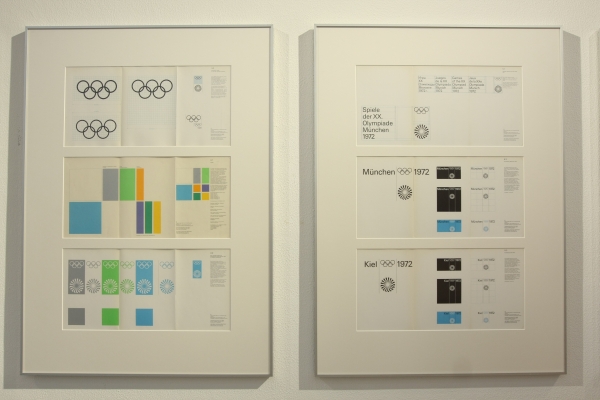
Guidelines and Standards for the Visual Design for the 1972 summer Olympics by Otl Aicher, as seen at SYSTEM DESIGN. Über 100 Jahre Chaos im Alltag, Museum für Angewandte Kunst Köln
Although many of us automatically think of furniture systems when thinking of design systems, for René Spitz design systems have a much wider history, “the development of the idea of systems developed parallel to the development of design as a key component of industrialisation”, he says, “starting with, for example, Peter Behrens and his work for AEG in the 1920s where he deliberately set out to connect the various aspects of his graphic design, product design and architecture work into a unity in which the system had more value than the sum of the individual components.” As industrialisation developed so to did the number and variety of design systems, for all furniture systems and media systems – Marcel Breuer‘s steel tube furniture, the ESU system from Charles and Ray Eames and the associated “Eames House”, Ferdinand Kramer’s furniture for the Neue Frankfurt urban regeneration project or the ADD system by Werner Aisslinger, to name just a handful of those furniture systems featured in System Design. In the 1980s Post-modernism did what Post-modernism did best and tried to derail the accepted logic of systems in design, but you can’t derail design ideas, only give them fresh impetus, and so since the 1990s the system has continued it’s development, albeit freed from the conservative formal restrictions of yore.
The logical consequence of system design’s shadowing of industrialisation is that it has followed industry into the post-industrial age and in our modern, digital world components of systems and the connectors which link them have largely ceased to be tangible products and instead tend to be abstract concepts. iTunes software may allow you to play the same song on any number of end devices. But who truly understands how it works? Certainly a lot less people than understand the String shelving system.
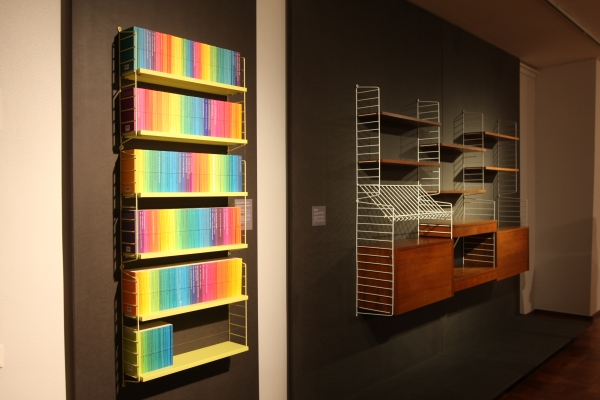
The String shelving system and a selection of books from the edition suhrkamp range, as seen at SYSTEM DESIGN. Über 100 Jahre Chaos im Alltag, Museum für Angewandte Kunst Köln
Given that the exhibition is about systems and design, the exhibition design is somewhat unsystematic. But not chaotic.
“Arranging such an exhibition chronologically makes no sense”, explains René Spitz, “and so instead we decided “all objects are equal” and took a much freer approach to the organisation, largely arranging the rooms according to questions of space, dimension or lighting requirements”
The result is an exhibition design which does take a little bit of getting used to – in exhibitions one is used to a given “structured” layout, be that thematically or chronologically, and when that isn’t there one does stand about a bit like an astronomer’s apprentice on their first evening, staring, forlornly, at the endless bright points in the sky and hoping to find some form of orientation; however, once you start working your way through the three exhibition rooms, a natural logic does arise.
And with it comes the understanding that what we each individually understand as a system depends on our individual perspective and perception. Systems exist in manifold forms, and often aren’t instantly obvious. At least not without the necessary knowledge. Whereas, for example, some will instantly understand the Heckler & Koch HK G36 machine gun as a piece of system design. Others will just see a gun.
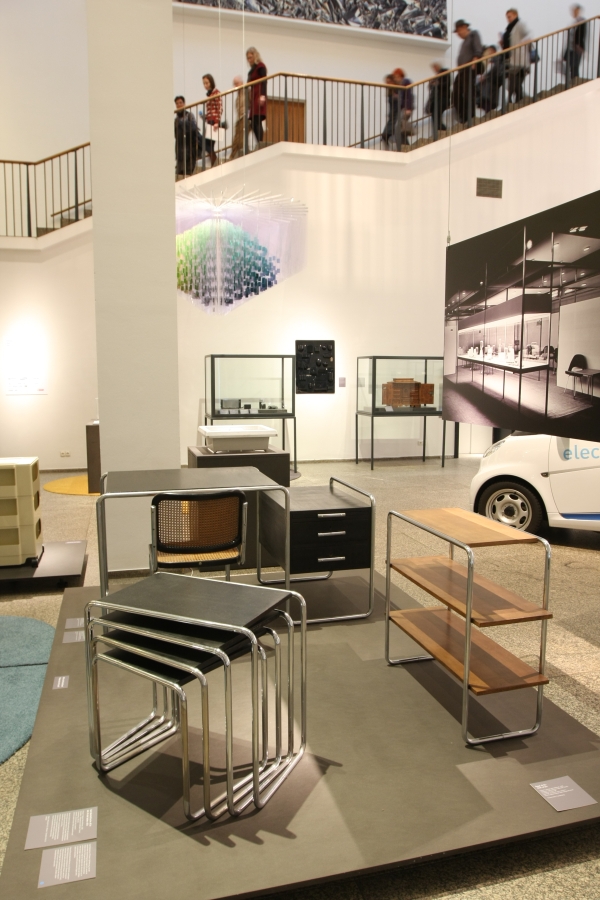
Marcel Breuer for Thonet, as seen at SYSTEM DESIGN. Über 100 Jahre Chaos im Alltag, Museum für Angewandte Kunst Köln
A very well conceived and executed exhibition System Design presents an interesting mix of objects and genres and provides the necessary background information to allow all visitors to clearly understand the exhibits status as systems in a succinct yet thorough manner which is often lacking in other exhibitions.
What System Design also makes very clear is that despite René Spitz’s universal definition of what constitutes a system, when one gets into details the “system” becomes such a vague, abstract concept that it more or less ceases to have any real universal meaning. Every system may require a connecting element, but beyond that there are no rules.
No connections, if you will.
Which doesn’t make the exhibition not worth viewing. Far from it, for this understanding forces you to analyse in more detail the things that surround you. And the more you look the more design systems you find, the more design systems you understand, the more everyday objects you understand as nodes in an economic system and so the more you begin to question design systems.
And ultimately you understand that in contrast to natural systems, design systems can be reconfigured, re-designed, to optimise their benefit.
And when you understand that, you have taken a step further forward and opened new possibilities
SYSTEM DESIGN. Über 100 Jahre Chaos im Alltag can be viewed at the Museum für Angewandte Kunst, An der Rechtschule, 50667 Köln until Sunday June 7th
Full details can be found at www.makk.de
- SYSTEM DESIGN. Über 100 Jahre Chaos im Alltag at the Museum für Angewandte Kunst Köln
- Marcel Breuer for Thonet, as seen at SYSTEM DESIGN. Über 100 Jahre Chaos im Alltag, Museum für Angewandte Kunst Köln
- The String shelving system and a selection of books from the edition suhrkamp range, as seen at SYSTEM DESIGN. Über 100 Jahre Chaos im Alltag, Museum für Angewandte Kunst Köln
- Spazio Office System by Studio BBPR for Olivetti, as seen at SYSTEM DESIGN. Über 100 Jahre Chaos im Alltag, Museum für Angewandte Kunst Köln
- Peter Behrens designs for the AEG customer magazine, (1907/08) and a USM Haller sideboard by Fritz Haller, as seen at SYSTEM DESIGN. Über 100 Jahre Chaos im Alltag, Museum für Angewandte Kunst Köln
- LEGO, as seen at SYSTEM DESIGN. Über 100 Jahre Chaos im Alltag, Museum für Angewandte Kunst Köln
- M125 shelving system and Play Furniture System by Hans Gugelot, as seen at SYSTEM DESIGN. Über 100 Jahre Chaos im Alltag, Museum für Angewandte Kunst Köln
- SYSTEM DESIGN. Über 100 Jahre Chaos im Alltag at the Museum für Angewandte Kunst Köln
- 606 universal shelving system by Dieter Rams and ADD furniture system by Werner Aisslinger, as seen at SYSTEM DESIGN. Über 100 Jahre Chaos im Alltag, Museum für Angewandte Kunst Köln
- Furniture by Ferdinand Kramer for the Johann Wolfgang Goethe University Frankfurt and the painting “Gleichzeitigkeit von System und Chaos, Sinn und Unsinn” by Oliver Scheibler, as seen at SYSTEM DESIGN. Über 100 Jahre Chaos im Alltag, Museum für Angewandte Kunst Köln
- Action Office Office Furniture System byGeorge Nelson, as seen at SYSTEM DESIGN. Über 100 Jahre Chaos im Alltag, Museum für Angewandte Kunst Köln
- Guidelines and Standards for the Visual Design for the 1972 summer Olympics by Otl Aicher, as seen at SYSTEM DESIGN. Über 100 Jahre Chaos im Alltag, Museum für Angewandte Kunst Köln
Tagged with: cologne, köln, MAKK, Museum für Angewandte Kunst Köln, SYSTEM DESIGN. Über 100 Jahre Chaos im Alltag
